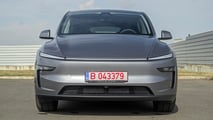
Tesla sales are suffering around the world, but especially in Europe. EV buyers here are ditching the brand following its boss’ political pivot and support of President Trump’s policies, many of which seem designed to break the longstanding friendship between the United States and the European Union. Luckily, Europeans have a wider assortment of Tesla alternatives than American buyers, and they are taking full advantage of these choices.
Europeans not only have more locally made EVs to go for but also an increasing number of highly tempting vehicles being imported from China, which are still coming to Europe despite tariffs. Even if you ignore Tesla completely, there has never been a better time to buy an EV in the EU. Sales data from the continent shows that the pace with which car buyers are abandoning pure combustion cars in favor of electric or electrified and cars seems to be accelerating.
Tesla topped the European sales charts in 2024, riding on the success of the Model Y, but it may be dethroned if the anti-Tesla sentiment persists. We recently drove the revised Tesla Model Y, which is marginally more efficient and shows improvements in many areas. However, driving it also put into perspective just how much more competitive its market segment is these days, with lots of talented rivals vying for supremacy.
Gallery: 2025 Tesla Model Y Launch Series (Euro-spec)







The same goes for the Model 3, which was updated last year. It’s also an excellent EV—probably the best in its class for the money—but it too faces a series of highly capable rivals. Buying an EV in the segment is no longer as simple as just buying whatever Tesla has on offer.
Still, European roads are full of Teslas, and the Model Y is the most common. These things are everywhere, and that’s unsurprising for the world’s best-selling vehicle two years in a row. As a package and value-for-money proposition, it’s hard to beat. The base standard-range rear-wheel drive Model Y costs €44,990 before any national EV incentives are applied, and these are around €5,000 on average in EU countries.
If you want the long-range rear-wheel-drive Model Y, which bumps WLTP range from 310 miles (500 km) to 386 miles (622 km), the price goes up to €49,990. The €52,990 dual-motor big-battery Model Y cuts the acceleration time to 62 mph (100 km/h) from 5.6 to 4.8 seconds. Range falls to 364 miles (586 km), but it’s considerably quicker feeling and more capable thanks to all-wheel drive. But while these are solid options, they aren't the right fit for everybody. Let's break down the best Tesla Model Y alternatives for buyers in Europe.
Skoda Enyaq

We drove a Skoda Enyaq a few years ago, and we appreciated it especially for its high-quality, almost luxurious-feeling interior, oodles of space and excellent road manners. The Enyaq is still around, and while it’s not been a sales champ in Europe, it’s still a solid choice.
Since the last time we drove it, the model got a visual makeover. It now starts at €44,400, undercutting the cheapest Model Y. The base Enyaq gets a 59-kWh battery, giving it up to 268 miles (432 km) of range, and its single rear-mounted 204 hp motor can propel it to 62 mph in 8.1 seconds.
The longest-range Enyaq is the 85 model, which gets a 77 kWh battery that increases claimed range up to 359 miles (578 km), and the motor gets a power bump to 286 hp, which drops the sprint time to 6.7 seconds. The dual-motor 85x variant has the same output and acceleration time, but WLTP range drops to 341 miles (549 km).
Skoda also offers the Enyaq Coupe, a coupe-like fastback roofline that sacrifices some practicality for a sportier look. Thanks to better aerodynamics, the rear-motor 85 model is quoted at up to 370 miles (596 km) WLTP.
Cupra Tavascan

Based around the same Volkswagen MEB platform as the Skoda Enyaq, VW ID.4 and Audi Q4 E-Tron, the Cupra Tavascan tries to project a sportier image than all of them. It has a coupe-SUV body, like the VW ID.5 or Skoda Enyaq Coupe, but it looks a lot more aggressive than all of them.
It starts at just under €50,000, which varies slightly from market to market, and there’s no low-power, small-battery model. It comes with a 286 hp rear motor and large 77 kWh battery pack as standard, giving it a zero-to-62 mph of 6.8 seconds and a WLTP range of 339 miles (547 km). The dual-motor Tavascan has 340 horsepower. Opting for all-wheel-drive cuts the sprint time to 5.6 seconds and the range to 354 miles (517 km).
BYD Sealion 7

BYD is slowly establishing itself in Europe these days, and the Sealion 7 is one of its most important models. In Germany, it starts at €47,990, and for that you get a 313-hp motor that drives the rear wheels and an 82.5 kWh battery good for a sprint time of 6.7 seconds and 299 miles (482 km) of WLTP range.
You can add a second motor to drive the front wheels for all-wheel drive and 530 hp combined, which lowers the acceleration time to 4.3 seconds and the range to 283 miles (456 km). There’s also a larger 91.3 kWh battery that ups range to 311 miles (502 km), but its extra weight adds two-tenths to the acceleration time.
It’s worth noting that even though the Sealion 7 is roughly the size of a Model Y, the small-battery variant weighs over 4,850 pounds (2.2 metric tons), which is over 660 lbs (300 kg) heavier than the big-battery Tesla. This shows in the BYD’s handling, which feels cumbersome compared to the lighter and more agile Tesla.
Xpeng G6

Another tempting Chinese Model Y rival in Europe is the Xpeng G6. Its base price in Germany is €47,600, which gets you a single-motor G6 with 296 hp and a 66 kWh battery. The small battery nets the base G6 a WLTP range of 270 miles (435 km), which can be increased up to 354 miles (570 km) with the optional 87.5 kWh battery.
You can also get it with a 487 hp dual-motor setup that propels the G6 to 62 mph in 3.9 seconds. Just like the Sealion 7, though, it’s a bit heavier than it should be for its size. It weighs over 4,600 lbs (2.1 metric tons) in dual-motor guise, and it’s not that great to drive even though its suspension is quite stiff. Its design also looks a bit derivative, and it doesn’t really have a strong identity, making it the perfect car to help you pass by unnoticed.
Zeekr 7X

Geely-owned Zeekr announced pricing for its 7X electric crossover in Europe late last year and promised that the 800-volt model would start at €52,900, with deliveries commencing this summer. It’s built on the same SEA platform shared with Geely brands, including Volvo, and you can get it with either a 75-kWh battery that’s good for 298 miles (480 km) WLTP or a 100-kWh pack that gives you 382 miles (615 km) of range.
It’s one of the more powerful vehicles in the segment. Its base single-motor version pushes 416 hp to the rear wheels, which is enough to dispatch the 0–62 mph sprint in 6 seconds. The dual-motor all-wheel drive model gets 637 hp, and the acceleration time drops to 3.8 seconds. The top-of-the-range Performance variant with two motors and the big battery costs from €62,990.
Onvo L60

Nio’s more affordable sub-brand, Onvo, announced that it plans to offer its L60 Model Y rival in Europe starting in 2025. However, the tariffs now being imposed by the European Union may have made it alter its plans, so, for now, the L60 is only available in the UK, where it is expected to cost just over £40,000 (€47,800).
Renault Scenic E-Tech

Just like Chinese car buyers prefer to buy local brands, Europeans do too, and the new Renault Scenic E-Tech is expected to be a hit. Renault repurposed the nameplate, which was previously used to designate people carriers on an electric SUV. It’s one of the most stylish offerings in the segment, and it has great specs, too.
The base model costs around €41,000 depending on the market, and it comes with a 170 hp motor that draws from a 60 kWh battery with 261 miles (420 km) of range. You can upgrade to a 218 hp (still front-wheel-drive) Scenic that also gets a larger 87 kWh battery, pushing range to 385 miles (620 km).
Peugeot e-5008

Renault’s traditional French rival Peugeot also offers a model in the segment, the e-5008, which has more power and range and is available with all-wheel drive. The €51,150 entry variant has a single front motor with 213 hp and a 73 kWh battery that’s good for a claimed 312 miles (502 km).of range The bigger 98 kWh battery takes the range to 410 miles (660 km), and it’s marginally more powerful at 231 hp.
If you want all-wheel drive, that’s only available in combination with the smaller battery. It adds a motor on the rear axle for a combined 326 hp, which doesn’t affect range too much as it’s still quoted at 310 miles (500 km) per charge.
Opel/Vauxhall Grandland Electric

The Opel Grandland Electric (sold as a Vauxhall in the UK) is built on the same platform as the e-5008. Its specs are identical to the Peugeot’s, but the entry price is a bit cheaper at €46,750, and it drives a bit further on the 73 kWh battery. The claimed WLTP range is up to 325 miles (523 km), and you can also get it with a larger 82 kWh battery that extends it to 363 miles (585 km).
There’s no all-wheel-drive option available for the electric Grandland, but for the kind of life these vehicles lead, that’s not an issue. Its more conservative and minimalistic design is more traditional, and it doesn’t advertise the fact that it’s electric as much as the Peugeot does, and its interior is also more conservative and traditional-looking. That could be the perfect antidote for someone turned off by the Model Y's hyper-modern interior. But regardless if the Opel is the one for you, it's safe to say there are plenty of options here without a Tesla badge.







